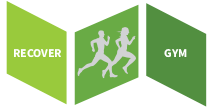The hip is one of the most stable joints we possess, which at the same time is also quite mobile. It helps absorb shock and reduce the energy demand of standing. This requires many strong ligaments in order for the joint to remain stable. But it also has to be mobile, which means the strongest muscles are located in the hip, in order for them to be able to swing back and forth as a pendulum whilst walking or running.
If the muscles and ligaments don’t have proper teamwork, there’s a tendency to develop joint issues, which are deeply placed due to the location of the hip joint.

Find your injury in the list below:
Iskias syndrom
- Radiation down the back of the thigh, the outside and front of the lower leg, the outside and the front of the foot.
- The symptoms worsen if you get up from a sitting position, ascend the stairs or drive a car for a long time.
- The symptoms decrease if you exercise, ex. jogging or running.
Piriformis syndrome
- Pain in the lumbar part or in the buttocks.
- Radiating pain.
- The pain increases with the load.
- Pain or radiation when walking / running.
- Restlessness in the leg when resting.
- Irritation when driving a car where you can’t really find a good sitting position without it causing irritation in the buttock or leg.
Runner’s back
- Runner’s back: Basically, you can divide the injury into two types:
- If the injury is double-sided, the injury will most often be located in the back, where excessive curvature of the spine will usually be visible and / or back pain initiates when training begins or after training. The pain will most likely be related to strong hip stretches; e.g. in running, hence the name “Runner’s Back”.
- If the injury is unilateral, the injury will be felt in the attachment area of the groin and possibly in the bursae. It’s not strong enough to pull the back into a sway. The pain is most often provoked by heavy hip stretching and use; e.g. running, soccer and the like.
Runner’s back / double-sided iliopsoas syndrome
- Runner’s back: Basically, you can divide the injury into two types:
- If the injury is double-sided, the injury will most often be located in the back, where excessive curvature of the spine will usually be visible and / or back pain initiates when training begins or after training. The pain will most likely be related to strong hip stretches; e.g. in running, hence the name “Runner’s Back”.
- If the injury is unilateral, the injury will be felt in the attachment area of the groin and possibly in the bursae. It’s not strong enough to pull the back into a sway. The pain is most often provoked by heavy hip stretching and use; e.g. running, soccer and the like.
Groin injury/pull/strain (Adductor rupture)
- The tenderness of the adductor muscle group (adductor brevis, magnus, longus) will often be localized as soreness in the groin and may be difficult to distinguish from other types of groin pain.
- Pain while using or stretching the muscles.
Hamstring muscle injury
- Soreness at the back of the thigh i.e. hamstring (m. Semitendinosus, m. Semimembranosus and m. Biceps femoris).
- Pain during use or stretch of the muscles.
Snapping hip (coxa saltans)
- In the external snapping hip there will often be a clicking sound and sensation from the outside of the hip, which can lead to pain, fatigue, and overtraining of the area.
- In an internal snapping hip, there will often be a clicking sound and sensation from the inside of the hip / high in the groin, which can lead to pain, fatigue and overtraining of the area.
- In the intra-articular snapping hip there will often be a clicking sound and sensation from the inside of the hip joint. This can lead to pain, often in a deep hip bend, as well as a feeling of fatigue and overtraining in the area. Just as it can give a sense of looseness and instability in the joints.
Lower Crossed Syndrome (Pelvic / hip imbalance)
- Runner’s back (lower back pain).
- Hamstring (back of thigh) injury.
- Injuries in the groin.
- Global back problems.
Osteoarthritis of the hip (hofte artrose)
- Pain around the hip joint during activity.
- Pain and discomfort when leaving rest.
- Later in the progress in all situations also at rest.
- Compensatory pain and discomfort in the legs and back.

Social Medier